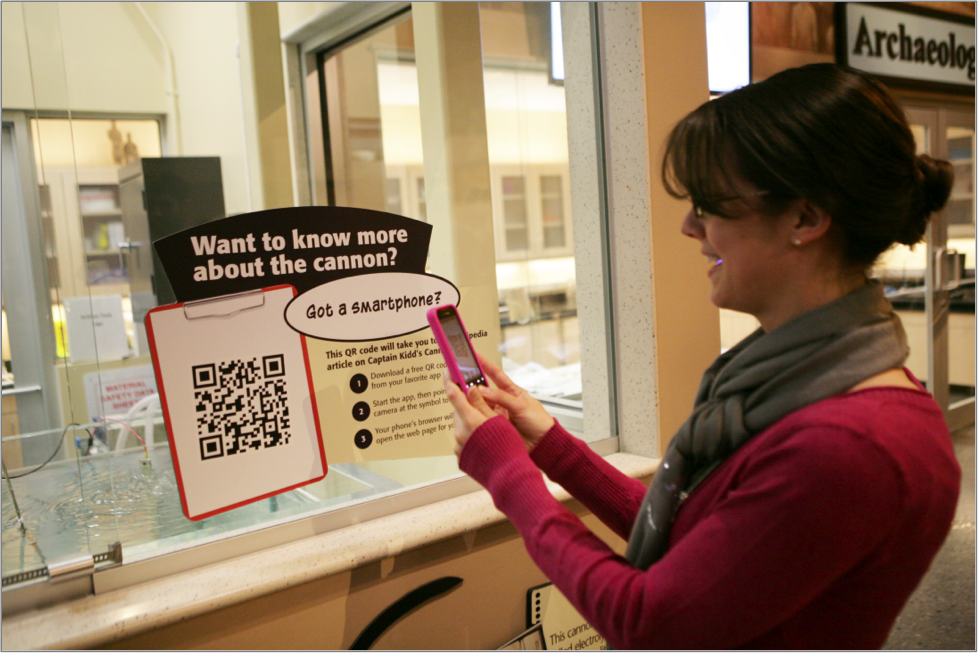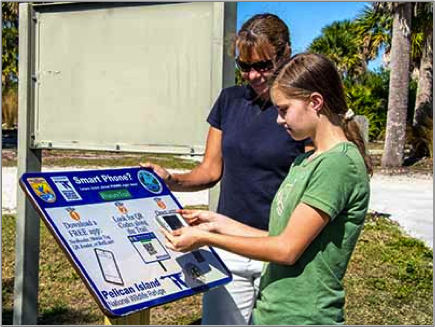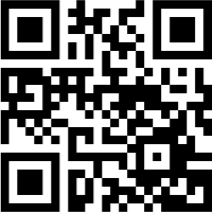
Link and Learn: How to Use QR Codes to Communicate Science
By: Claire Moore, Kristin Davis, Shelley Spear, and Sara Bombaci

What are QR codes?
Quick-response (QR) codes are simple square-shaped pixelated barcodes that contain data. They allow the user to easily access websites, videos, text, maps, pictures, or contact information with a quick scan using their camera-equipped mobile device and a free QR code reader app. There are many free resources for generating and reading QR codes for almost every smartphone or tablet with a camera, making them an easy and inexpensive way for learners to access media on a mobile device.
Two types of QR codes are available – static and dynamic. Static QR codes contain data that cannot change once the QR code is printed. Dynamic QR codes include a short URL that is contained in the QR code itself, allowing users to change where the short URL redirects to even if the QR code has already been printed.
As a scientist, why care about QR codes?
The limited amount of time and space allotted to present research findings often constrains the ability of scientists to communicate the potential implications of our work. Now more than ever, we seek creative and effective ways of interacting with diverse audiences about scientific topics. QR codes offer an opportunity to expand on our research and connect with people in a variety of ways. Content linked to a QR code, for example, may be used to describe an in-depth sampling protocol for data collection including photos or how-to videos. A QR code may be added to a conference poster or presentation final slide to provide the audience an opportunity to follow-up and learn more, linking users to the author’s research website or supplemental information. An author may also provide a QR code within a scientific article that grants access to the investigator’s data set or analysis tools. This helps clarify analysis techniques among scientific studies that address similar content.
Outside of the scientific community, QR codes allow scientists to extend their work beyond peer-reviewed journals with limited readership to engage an array of audiences. Many examples exist of such applications, including in parks and protected areas where QR codes are being used to enhance a visitor’s learning experience. For instance, visitors to

Credit: Vince Lamb.
the Pelican Island National Wildlife Refuge in Florida can access educational videos and additional photos along the refuge’s trail system that provide an opportunity for connecting people to place in an interactive and inquisitive way. By using QR codes, the refuge provides supplemental information to guests with minimal physical signage, thereby keeping the trails natural and the visitors engaged. Here is an example of a QR code-supported video experience from Pelican Island.
QR codes are already connecting people with science
- Enhance Your Next Conference Poster with a Video
- Modern Technology on Historic Refuge
- Walking Tours to Teach Climate Literacy – Video archive of live webinar from NOAA Climate Stewards Program
- World Wildlife Fund: Ice QR Codes
- National Park Service on using QR Codes: What are they?
- McGraw-Hill connects textbook users with interactive learning modules via QR codes
- An Evaluation of the Learning Effectiveness of Concept Map-Based Science Book Reading via Mobile Devices
How would you use QR codes to communicate your science in a new way?
How to make a QR code
Once you have thoughtfully constructed the content, chosen your preferred QR code format, and selected a corresponding URL, you’re ready to create a code and get your message out. Making a QR code is easily accomplished by the following steps:
- Choose a QR code generator. A quick Google search will produce many options for QR code generators, including goQR.me, TAGO, QR Stuff, and QRCode-Monkey.
- Copy the URL (or other alphanumeric data) that you want the code to link to into the appropriate section of the QR code generator.
- Decide if you want to customize the color or shape of the QR code. QR codes typically appear black on a white background, but other colors can be used as long as the contrast is high between code and background.
- Save the QR image as a vector file (e.g. a PDF), download the image to your computer, and place it onto your desired medium. You may want to give some direction along with the QR code so people know why it is there and what to do with it. While QR codes have been used successfully in advertising and marketing, their appearance in other contexts may be less familiar and benefit from clear instruction.
Most generators offer both free and paid services. FreeQRCodeTracker offers a quick video on how to create a QR code, and the YouTube video How to Create QR Codes by Derral Eves goes into a little more detail.
How to scan a QR code
Just as there are numerous QR code generator websites, there are also many free QR code reader apps available for easy download. A few examples include ScanLife, QR Code Reader and Scanner, and QR Barcode Scanner.
Once the app is downloaded on your mobile device, simply open the app and point your device’s camera at the QR code to scan it. Most QR code reader apps will make an audible noise when the code has been successfully recognized and take you directly to the corresponding media.
What about the times when you do not have cell reception or internet access and come across a QR code you want to scan? Apps like Qrafter allow you to upload a picture of a QR code taken with your mobile device’s camera to view the information whenever you are back in service or the mood strikes.
Static vs. dynamic QR codes
There are advantages and disadvantages to each type of QR code. The majority of QR generators offer static QR codes for free, whereas dynamic QR codes are often only available with a paid subscription. The website URL that appears when you scan a static QR code may be more recognizable than a dynamic QR code URL, since a static code sends you directly to the intended website, instead of through a shortened redirect URL first. Additionally, static QR codes allow websites to track how many users access a site via QR scans (more complex methods may be required for dynamic QR codes). The end URL information contained within dynamic QR codes may be edited as often as needed without having to reprint the code, making dynamic codes more versatile.
General shortcomings
Accessing QR code-linked information requires the user to have a working mobile device equipped with a camera and a QR code scanner app (or the ability to download one). Users may not always have their mobile devices where QR codes are provided. In other words, just because you own a cell phone doesn’t mean you always carry it with you to a conference presentation or on a hike in a park or wildlife refuge. As mentioned earlier, it may also be beneficial for scientific authors to include QR codes in their peer-reviewed articles to provide access to datasets or software code. A potential limitation to this idea is that the reader may only access this supplementary information on their mobile device. An extra step is then required to transfer the information onto a computer and view it more comprehensively. Many websites are not currently mobile friendly, which exacerbates the need to transfer QR code content to a computer. Furthermore, linking a QR code to content that was not thoughtfully developed to communicate the intended message detracts from the usefulness of the technology, or worse, confuses the user’s understanding of the topic.
Take home message
QR codes provide an interactive and creative way to share relevant content through an easily accessible electronic platform. As QR codes become more popular in the science realm, we can quickly meet inquiries with answers and solutions, connect people with ideas, and communicate the results of rigorous science. QR code type and content should be thoughtfully developed for the desired context to maximize value and ensure continued relevance. Those interested in delving deeper need only a smartphone and an inquisitive mind to link and learn.
Tips for making and tracking QR codes
Adapted from Dawn Lanier’s 30 Ways to Use QR Codes to Reach More Customers
- Keep the message simple, including the information contained in the QR code itself. You can include graphics in the QR code (like a logo or other image), but the more complexity you put into the QR code, the greater risk there is for distortion.
- Test your QR code with different readers and devices to be sure it displays properly.
- Make sure your QR code sends users to links that are mobile-friendly.
- Track your QR codes to see where and how often they are being scanned. Some QR code generator websites also include an option to buy a tracking package that provides metrics for QR use, e.g. how many times a QR code was scanned and the geolocation of each scan. A few provide a limited free trial, free tracking for one QR code per user, or very basic free tracking software, but most do charge for this service (anywhere from about $10-200/month). Other options for tracking include using the media content’s own website tracking abilities or Google Analytics (see Resources below).
Resources to learn more
- Answers to your questions about the QR Code
- Dynamic QR Codes
- Using Google Analytics With QR Codes
- An introduction to using QR codes in scholarly journals
 Scan this QR Code to visit EcoPress and learn more about the science and scientists of Colorado State University’s Natural Resource Ecology Laboratory
Scan this QR Code to visit EcoPress and learn more about the science and scientists of Colorado State University’s Natural Resource Ecology Laboratory
Need a QR code reader? Try ScanLife or search for a free QR code reader from your app store. Simply download, open, and scan the QR code with your device’s camera.